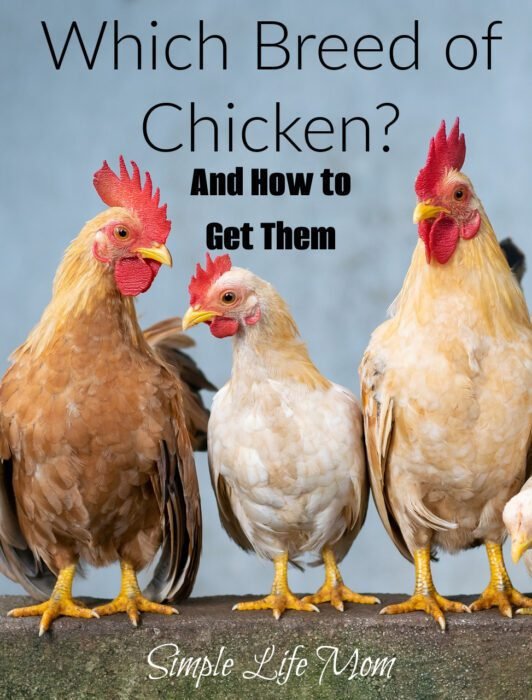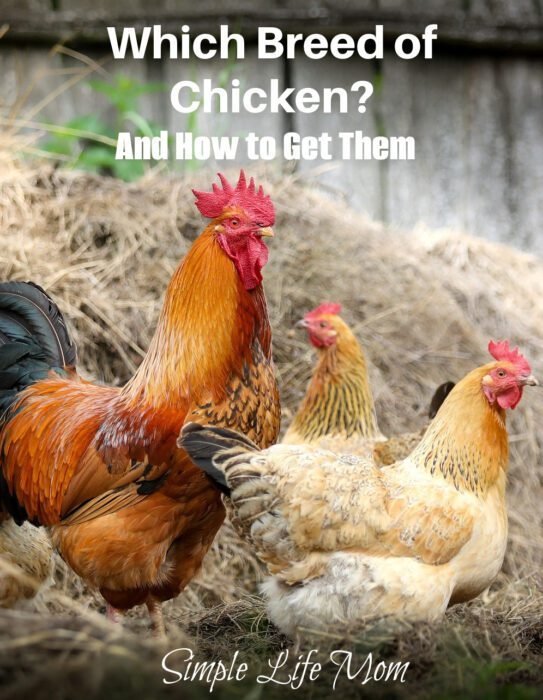If you’re just getting started with chickens, then check out my article on How to Start Raising Chickens in Your Back Yard. Once you have a general idea of what it takes, then the next step is to decide which breed of chicken you should buy and then how to get them.
Buying chickens can be a lot of fun.
For example, it can be as relaxed as choosing a mystery mixture and watching them grow, or hand picking each breed for their particular attributes.
There are a number of questions to ask before you decide on chicken breeds. The following information should help you get started.

Questions #1: Do you want an Egg Layer, Meat Bird, or a Dual Purpose Bird?
Those names are pretty self explanatory, except for a dual purpose bird. These are birds that you will raise for eggs and/or meat. You may keep some for eggs, but also butcher some for the cook pot. You can also wait until they’ve produced eggs for a while for you and then butcher for the pressure cooker (birds get very tough after they age, but a pressure cooker does wonders and they make great soup birds). A lot of these birds are meat birds, but considered heritage chickens. They are have a lot more meat on them than egg layers, but not as much as modern hybrid meat birds.
The rest of this article will focus on choices for those who choose to raise Egg Layers (though Dual Purpose birds also apply).
Questions #2: What color of eggs do you want?
The egg color is determined by the type of chicken. When I was a kid I thought the store must bleach eggs since all of ours were brown. In fact, stores do wash eggs in a wash of some kind, but they do not change their color.
One way to know what color of egg the chicken will have is by looking at the feather where their ear hole is. This little flap is often going to be the same or similar color to the egg. This isn’t always the case. A lot of black chickens are white egg layers.
Eggs can be white, light to super dark brown, or all types of pastel to brighter colors.
Why do the stores only have white and brown eggs? The main reason is that white egg layers tend to be the heavy layers. Chickens only have so many eggs to develop within them. Some lay a lot and some lay less.
Remember, most hatcheries offer a “mix bag” of day old chickens at a discount, where you can wait and see what you get. You can often request females. It’s a fun way to watch them grow.
Popular Breeds for Different Egg Colors
White Egg Layers
- Mottled Anocona
- White Leghorn
- Black Sumatra
- Belgian Bearded
- Blue Andalusian
Brown Egg Layers
- Orpington
- Barred Plymouth Rock
- Rhode Island Red
- New Hampshire Red
- Black Jersey Giant
- Golden Buff
- Blue Cochin
- Buff Brahma
Colorful Egg Layers
- Easter Egger
- Green Queen
- Ameraucana
- Legbar
- Olive Egger

Question #3: Do You Want a Heavy Layer or Less Often Layer?
Some chickens lay almost every day for years (minus winter time when chickens naturally slow to stop laying due to less light, colder temps, and less protein availability). Others will give you a few eggs each week (3-4). What does your family need?
If you have a big family, then you’ll want chickens that lay more often, or you’ll need to buy more chickens.
A lot of high production layers have a shorter lifespan and are hybrid breeds. This means that they don’t breed true if you try later to hatch some of their eggs (Remember, you need a rooster to hatch eggs).
High Egg Production Chickens:
- White Leghorns
- Golden Buff
- Barred Plymouth Rock
- Australorp
- Rhode Island Red
- New Hampshire Red
- Green Queen
- ISA Brown
Question #4: Is Lifespan Very Important?
The first hens we purchased were ISA browns. They are sweet and produce a lot of wonderful brown eggs. But their lifespan is short. Often, that is the tradeoff when choosing hens that are high producers. I didn’t realize that they would live only 3-5 years, while others lived 8-10! That’s a very big difference.
If you want eggs from girls that produce for more years, but a little less often per week, then choose heritage breeds like the Plymouth Rock, Orpington, or Cochin. We have each of these and I just love them. They are sweethearts.
If you want a higher egg producer that won’t live as long (3-5 years), then choose a breed like ISA brown, leghorns, or Rhode Island Reds.
Either way, if you buy chickens, you are committing to a 3-10 year adventure.
Question #5: Is Temperament Important to you?
Some people are very excited about certain breeds being the sweetest birds ever.
We have 22 birds at the moment, and only a few are of the same breed (I have fun buying new kinds). They are all super sweet! Some are more curious than others and some are more shy and more likely to run if you get too close. I think they’ve all had a lot of attention, but possibly some have more than others and that’s what’s making the difference.
In general, I have found that ISA Browns are not fearful and are very curious and friendly. So are Ancona, Welsummer, and Plymouth Rock.
My more shy birds are definitely cochins. Though they’re so fearful that they’ll squat and take their fate (you picking them up) instead of sprinting away. I love them! They are super sweet and my most likely girls to try and become broody (sit on a nest of eggs to hatch them).
Silkies tend to be very dumb (one of ours drowned in a pond he could have gotten out of). Their smaller size and sweet, funny temperament also makes them wonderful roosters! They are the only rooster that we haven’t had to put down for aggression, and they are good at rounding up the girls and watching over them (though he takes his cues from my Pekin drake Ferb).

Question #6: Do you want “normal” or funny looking chickens?
My son is the one who talked us all into getting chickens years ago. I thought it was a given that he would want some different and fun looking ones. Nope. He wanted the most typical chicken looking girls I could find. And they are beautiful!
After a while though, I wanted to get a few fun ones. After all, it’s just funny to look out the window and see a little poof ball or fuzzy legged chicken running around.
Some fun breeds to look into are:
- Frizzle anything (a lot of breeds have a frizzle variety now where the feathers grow in curly and kind of every which way).
- Polish birds have a top hat like they are going to a horse race.
- Silkies are adorable and full of sweet attitude (Our rooster is called Spinach Dip)
- Sultans have top poofs and long leg feathers
- Salmon Faverolles have beards. We have one (Sally) and she is so cute.
- Easter Eggers have poofy cheeks.
How to Buy a Chicken
Now that you know that you want, how do you get them?
There are actually a number of ways to get chickens, depending on where you live.
A Local Farm
Around Pennsylvania, there are farms that sell from their farm many months of the year. You can drive and pick up your chickens so that you don’t have to pay shipping fees.
A lot of times you can find these farms on Facebook or craigslist or by asking people in your area who have chickens where they got theirs. Sometimes, you can get some hatching eggs (and make new friends) by asking like minded people about their sources.
Online
A lot of people order online. Sometimes you can find places that sell online and will let you come pick up at their location.
Most of the time you need to have them shipped to you, though.
Yes, they ship day old chicks through regular mail. I get a phone call that they have arrived, and then go to my local USPS building (not the regular post office building). The postal workers usually like to take a peek and the little peeps too.
Companies won’t ship just one chick. They vary on policy, but most will want you to buy at least three so they can snuggle and keep warm while traveling. This goes for ducks as well (usually 2 are required).
Shipping can be expensive, so take advantage of Spring sales!
Companies will often shipping discounts if you purchase certain kinds of birds or certain amounts.
Online Hatcheries
- Meyer Hatchery – Based in Ohio, I’ve purchased a number of birds from Meyer. If one dies, they will replace it. You do have to purchase another one for it to be shipped with, but they will pay for shipping so it’s really only a few dollars and you end up with more chickens then you planned.
- McMurray Hatchery – Ships from Iowa. This is another great hatchery. The prices are better than a lot of online companies and they have a great selection and great prices.
- Cackle Hatchery – Based in Missouri, you can pick up or order online. Their shipping and fees are pretty standard and individual bird prices are pretty good. I’ve not used them, but I’ve heard a lot of good things.
There are a lot more. You can do a search for ones in your state to see if there are local pickup options or smaller shipping fees.
Where NOT to purchase chicks
Sorry, but I do not recommend Tractor Supply or Rural King. The employees have no idea what they are doing and the birds are not sexed. The employees don’t know what the chicks need, and you could end up with a lot of work ahead of you unless you decide to put the bird down.
We got Molly, our Pekin duck from Tractor Supply and even though we started her on brewers yeast and everything she needed, it was too late and she was severely handicapped after a few weeks, had seizures and broke her wing, stopped laying early, stopped walking, and eventually died. We didn’t put her down, because she had so many ups and downs it was hard to tell if she was going to thrive or not. And we loved her by then and the kids were attached (thus don’t take the risk).
Once at Rural King I was tempted to buy a few ducks and when I asked what breed they were the girl said, “Duck”. I said, “I know it’s a duck, but what kind of duck?” She said, “I think it’s brown.”
At Tractor Supply I had a guy who chose them for me (we couldn’t touch them) say he chose girls because they were all scared of his hand when he reached in. Yeah, they all ended up being roosters.
But if you want to take a risk and save a ton of money, try picking up some chicks from one of those stores, but I would never recommend getting ducks from there.





Leave a Reply
We'd love to hear your thoughts and ideas!